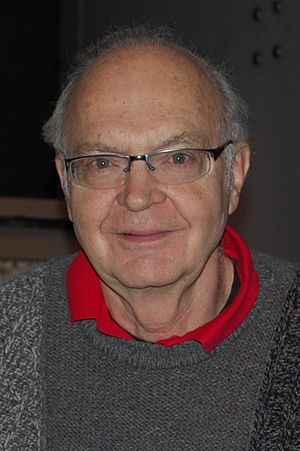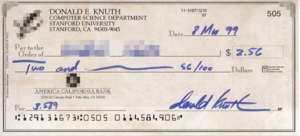Donald Knuth facts for kids
Quick facts for kids
Donald Knuth
|
|
|---|---|

Knuth in 2011
|
|
| Born |
Donald Ervin Knuth
January 10, 1938 Milwaukee, Wisconsin, U.S.
|
| Education |
|
| Known for |
See list
|
| Spouse(s) | Nancy Jill Carter |
| Children | 2 |
| Awards |
See list
|
| Scientific career | |
| Fields | |
| Institutions | Stanford University University of Oslo |
| Thesis | Finite Semifields and Projective Planes (1963) |
| Doctoral advisor | Marshall Hall, Jr. |
| Doctoral students |
|
Donald Ervin Knuth (born January 10, 1938) is an American computer scientist and mathematician. He is a retired professor from Stanford University. In 1974, he received the ACM Turing Award. This award is often called the "Nobel Prize of computer science."
Many people call Knuth the "father of the analysis of algorithms." This means he helped create ways to study how well computer programs work. He wrote a famous series of books called The Art of Computer Programming.
Knuth also created TeX, a computer system for making documents look good. He also made METAFONT, a system for designing computer fonts. He believes in "literate programming," which means writing computer code that is easy for humans to understand.
Biography
Growing Up and Early Life
Donald Knuth was born in Milwaukee, Wisconsin. His father owned a small printing business. Donald was very good at solving problems, even when he was young.
In eighth grade, he won a contest by finding many words from the letters in "Ziegler Giant Bar." The judges found 2,500 words, but Donald found over 4,500! He used a dictionary to help him. His school won a new television, and his classmates got candy bars.
Donald's Education Journey
In 1956, Knuth went to the Case Institute of Technology. He studied physics there. He learned about the IBM 650, an early computer. He even rewrote some of its code because he thought he could make it better.
In 1958, Knuth created a computer program to help his school's basketball team. He gave "values" to players to guess how likely they were to score. This idea was so new that Newsweek and CBS Evening News reported on it.
Knuth later switched from physics to mathematics. In 1960, he earned two degrees at once because his work was so good. In 1963, he earned his PhD in mathematics from the California Institute of Technology.
Starting His Career
After getting his PhD, Knuth became a professor at Caltech in 1963. He also worked as a consultant for Burroughs Corporation, a computer company. He helped them with computer programming.
In 1962, a publisher asked Knuth to write a book about computer programming languages. As he worked, he realized he needed to create a basic theory of computer programming first. This idea grew into his famous book series, The Art of Computer Programming. He first planned one book, but it grew to six, then seven volumes! The first volume came out in 1968.
In 1969, Knuth joined the faculty at Stanford University. He became a special professor there in 1977. He retired from regular teaching in 1993 to focus on his books.
Knuth's Writings
Donald Knuth is known for his writing as much as his computer science.
The Art of Computer Programming (TAOCP)
Knuth once said, "The best way to communicate from one human being to another is through story."
In the 1970s, Knuth felt that computer science was a new field without clear rules. He wanted to make sure the information was correct and well-explained. He decided to "put straight a story that had been very badly told."
He spent a year in Norway in 1972-1973. He planned to write about programming languages there. But he ended up working on the third volume of his book series. This volume was published in 1973.
The book Concrete Mathematics: A Foundation for Computer Science came from his TAOCP work. He realized students needed more math tools for computer science. He started a course at Stanford in 1970 to teach these tools.
By 2011, Volume 4A of TAOCP was published. Knuth expects Volume 4 to have at least parts A through F. Volume 4B was published in October 2022.
Other Books and Interests
Knuth also wrote Surreal Numbers. This book is a story about how a new system of numbers was created. He wanted to show students how to do their own creative research.
He has also written forewords for other math books. Knuth enjoys recreational mathematics, which is math done for fun. He has written articles for magazines about math puzzles.
You can also find Donald Knuth in videos on YouTube. He talks about his books and why he doesn't use email. Knuth once suggested "algorithmics" as a better name for computer science.
Books on Beliefs
Knuth is a Lutheran. He wrote a book called 3:16 Bible Texts Illuminated. In this book, he looks at chapter 3, verse 16 of each book in the Bible. Each verse has beautiful art by calligraphers.
He also gave lectures at MIT about religion and computer science. These lectures became another book, Things a Computer Scientist Rarely Talks About.
Thoughts on Software Patents
Knuth believes that very simple computer ideas should not be given software patents. He thinks these ideas should be obvious to others. He has shared his views with patent offices in the United States and Europe.
Programming Work
Making Digital Text Look Good
In the 1970s, publishers changed how they printed books. Knuth was unhappy with the quality of the new printing methods. He felt they were not as good as the old ones.
So, he took a break from his books to work on digital typesetting. He created TeX, a system that makes text look very professional. He also made Metafont, which helps design computer fonts.
Literate Programming Idea
While creating TeX, Knuth came up with a new way of programming called "literate programming." He thought programmers should write programs like works of literature.
He said, "Instead of imagining that our main task is to instruct a computer what to do, let us concentrate rather on explaining to human beings what we want a computer to do."
Knuth created the WEB system for this idea. WEB helps create both a readable description of a program and the actual computer code. A newer version, CWEB, works with languages like C++ and Java.
Knuth used WEB to write TeX and METAFONT. He published both programs as books in 1986. Around the same time, LaTeX, a popular system based on TeX, was developed.
Personal Life
Donald Knuth married Nancy Jill Carter in 1961. They have two children, John and Jennifer.
Knuth sometimes gives informal talks at Stanford University. He calls these "Computer Musings." He was also a visiting professor at Oxford University until 2017.
Knuth is also an organist and a composer. He and his father played the organ for their church. In 2016, he finished a piece for organ called Fantasia Apocalyptica. It was first played in Sweden in 2018.
His Chinese Name
Knuth's Chinese name is Gao Dena. Frances Yao gave him this name in 1977 before he visited China. In a Chinese translation of his book, Knuth explained that he liked his Chinese name. He wanted to be known by the many computer programmers in China.
Knuth's Sense of Humor
Knuth used to pay people who found errors in his books. He would pay $2.56 for mistakes. This was because "256 pennies is one hexadecimal dollar." He also paid $0.32 for good suggestions. These "Knuth reward checks" became very special to computer fans. Since 2008, he gives out "certificates of deposit" instead of real checks.
He once joked, "Beware of bugs in the above code; I have only proved it correct, not tried it." This means he was sure his code was right, but he hadn't tested it yet.
In 1957, he wrote a funny article called "The Potrzebie System of Weights and Measures." In it, he used the thickness of a Mad magazine as a unit of length.
To show what recursion means, Knuth made the index of his book refer "Circular definition" and "Definition, circular" to each other.
In his book Concrete Mathematics, he joked about teaching a "hard" math course. He said he would not teach about "aggregates" or "embedding theorems." He added that "Several students from the civil engineering department got up and quietly left the room."
In 2010, Knuth announced a funny, fake computer system called "iTeX." He said it would have features like 3D printing and sound.
Awards and Honors
Donald Knuth has received many important awards for his work.
- In 1971, he received the first ACM Grace Murray Hopper Award.
- He won the Turing Award in 1974.
- He also received the National Medal of Science in 1979.
- In 1990, he was given a special title: Professor of The Art of Computer Programming.
- He was elected to the National Academy of Sciences in 1975.
- In 1992, he became a member of the French Academy of Sciences.
- He was elected a Foreign Member of the Royal Society in 2003.
- An asteroid, 21656 Knuth, was named after him in 2001.
- He received the BBVA Foundation Frontiers of Knowledge Award in 2010.
- In 2012, he became a fellow of the American Mathematical Society.
See also
 In Spanish: Donald Knuth para niños
In Spanish: Donald Knuth para niños
- -yllion
- Attribute grammar
- Big O notation
- CC system
- Dancing Links
- Knuth–Bendix completion algorithm
- Knuth Prize
- Knuth shuffle
- Knuth's Algorithm X
- Knuth's Simpath algorithm
- Knuth's up-arrow notation
- Knuth–Morris–Pratt algorithm
- Davis–Knuth dragon
- Bender–Knuth involution
- TPK algorithm
- Fisher–Yates shuffle
- Robinson–Schensted–Knuth correspondence
- Man or boy test
- Plactic monoid
- Quater-imaginary base
- TeX
- Triangular number
- The Complexity of Songs
- Uniform binary search
- List of pioneers in computer science
- List of scholars on the relationship between religion and science


